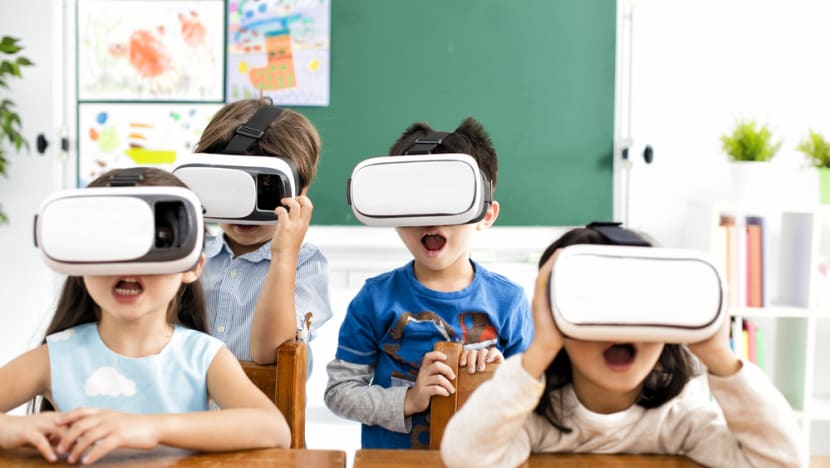5G: Empowering classrooms of the future
With digital learning on the rise, Singtel’s 5G network can create more immersive and enriching environments for students.

A safe and reliable Internet connection goes a long way in supporting the use of digital tools such as augmented reality to enhance learning. Photos: Shutterstock
As students start the new school year, they are also charging their devices and looking forward to an expanded definition of learning – one that takes place in the digital realm.
Once viewed as an additional resource, digital learning solutions are now considered a necessity, thanks in part to the COVID-19 pandemic. Newly developed augmented reality (AR) and virtual reality (VR) resources for education look set to revolutionise the learning process, making it more interactive, exciting and hands-on.
A fast, stable and secure Internet connection is essential for learning technologies to bear fruit. It can be distressing for students when the Internet connection drops and causes a livestreamed class discussion to be interrupted or a video call consultation with a teacher to be cut short.
"Given the current pandemic, interactive technologies and video-based applications like Zoom have made learning safer. But for the learning experience to be optimal, a stable and speedy Internet connection is crucial," said first-year polytechnic student Ho Nhat Tien, 17.
EMPOWERING STUDENTS WITH 5G
With excellent connectivity, however, the potential for the application of digital tools in education is vast. Having a powerful 5G network, for example, enables unprecedented advances in AR and VR, which were previously hampered by the limitations of 4G technology.

A common problem with VR is the nausea caused by the lag in motion. When the user moves his hand, for example, there may be a time lag before he sees his VR avatar’s hand move. This lag is the result of high latency – the time taken for data to be decoded at its destination after transmission. According to Ericsson.com, a lag can be perceived when latency reaches somewhere between 75 and 100 milliseconds. The lower latency of 5G networks can greatly minimise the mismatch in action and response – and the resulting discomfort – allowing students to fully benefit from learning via VR. With VR, textbooks can come to life, taking students into the heart of a volcano or allowing them to interact with historical figures.
In addition, 5G allows the burden of processing and rendering visuals to be moved from the VR headset to the cloud. This reduces costs, enables the development of smaller and lighter headsets, and empowers educational content developers to be more creative without the shackles of hardware limitations.
Collaborative tasks, such as working together remotely on editing a video for school or participating in online team-based competitions, is another important aspect of education that can be empowered by 5G connectivity.
While current online learning encourages collaboration via breakout rooms, this can again be thwarted by bandwidth and speed issues. Students who constantly experience lag or get disconnected from video calls will find participation to be a frustrating and unproductive experience.

The consistency and lower latency of a 5G network like Singtel’s ensure that students have a smooth and seamless collaboration experience. Whether they are working on a group science presentation or painting a digital mural as a team, they can work just as closely as if they were in a real-life classroom.
ESSENTIAL FEATURES THAT SUPPORT ONLINE LEARNING
Singtel’s 5G network is defined by five key qualities: Ultra-fast, ultra-smooth, ultra-responsive, ultra-consistent and ultra-secure. Given that many students are young, security is especially important for parents’ peace of mind while their children use their own or the family’s devices. 5G harnesses the defensive technologies of 4G while adding features such as stronger data encryption.

Speed, of course, is crucial. In an analysis of Speedtest Intelligence data from the third and fourth quarters of 2021 by Ookla, Singtel had consistently come in tops for the speed of its 5G network in Singapore, which reaches up to a blazing 1.2Gbps.
The network’s consistency and responsiveness also ensure that students enjoy a lag-free, continuous connection whenever and wherever they need it, so they can focus on their learning and not have to deal with disruptions caused by a spotty connection. "A good internet connection ensures that I will be able to access information anytime and at any place. This is crucial as I am frequently do research online. To illustrate, when I am unsure of the definition of a word, I simply do a quick Google search to get its meaning and stream the audio of its pronunciation, said Mr Ho.
A reliable connection gives students the flexibility to continue their studies anywhere – for example, they can listen to a livestreamed lecture during the commute to school or attend online classes while at a cafe. With Singtel’s 5G network covering over 1,000 sites indoors and outdoors that span 75 per cent of Singapore, their learning won’t be bound to any one location.

Powered by 5G, education is able to take on a new dimension that is immersive, borderless and seamless in which students can learn anytime, anywhere.
Find out more about Singapore’s most powerful 5G network*.
*Based on analysis by Ookla of Speedtest Intelligence data Q3–Q4 2021. Ookla trademarks used under licence and reprinted with permission.















